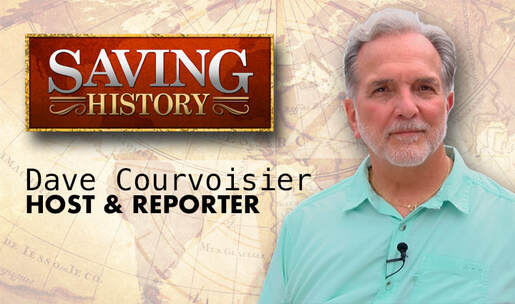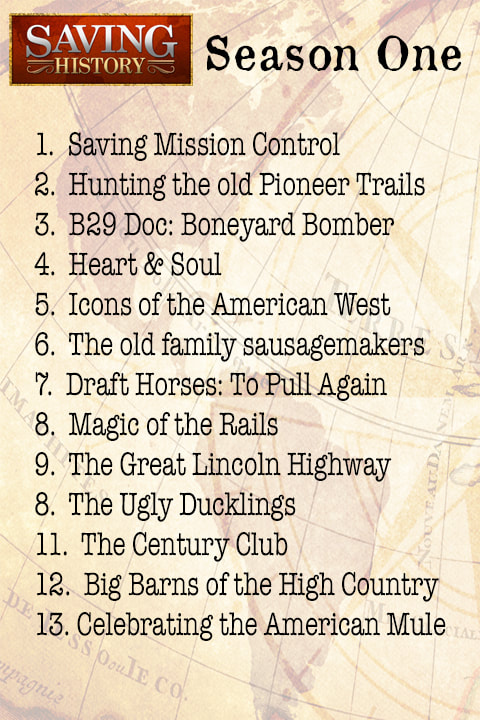|
|
American history is rich, diverse, and at times, inconceivable; so much so, that today’s generation is right to ask, “How did we get here?” Reading about it is a good start, but does not compare to personally visiting, seeing, and touching the places and things that gave us our heritage. Those remnants, though, become increasingly rare through the march of time. The people who made history, the stories they pass down, the physical artifacts, even understanding how yesteryear’s technology worked – all have a way of fading into today’s surplus of information and sensory overload.
|
Luckily, there are those whose passion keeps the past vibrant; people rolling up their sleeves to save old historic buildings, machines, trails, roads, forgotten traditions and lost techniques of making all sorts of things by hand and elbow grease. Most importantly, they are dedicated to saving the rich truth of our past. Each in their own way is Saving History. The opportunities to watch them work, record their efforts, then share the pictures and stories of their deeds contributes to the preservation of history.
Oldstrand.com is creating a new television and online program to be shared with PBS stations telling those stories. As you can see below, the first season of programs, is in development now. Our sponsorship partner will not only help fund this important program for PBS stations around the country, but by profiling various volunteer and non profit groups, will directly help save that history.
Oldstrand.com is creating a new television and online program to be shared with PBS stations telling those stories. As you can see below, the first season of programs, is in development now. Our sponsorship partner will not only help fund this important program for PBS stations around the country, but by profiling various volunteer and non profit groups, will directly help save that history.
Feedback from our viewers
|
Dave is an Emmy award winning journalist who spent much of his career as the main news anchor at KVBC-TV (NBC) and then KLAS-TV (CBS) in Las Vegas. He’s covered everything from hurricanes, earthquakes, wildfires, and OJ Simpson, to Papal visits and flying with the Air Force Thunderbirds. In his 4 decades of broadcast journalism, he’s gleaned innumerable awards and honors. He now calls Missouri home, but his new address is really behind the wheel of his pickup truck, traveling the backroads of America, meeting the men and women making a difference preserving our past. A lifelong volunteer himself for a variety of service organizations including Big Brothers/Big Sisters, Boystown, CASA, and The Adoption Exchange, Dave is all about giving back to the community, and loves telling the stories of these memorable people who are Saving our History.
|
A sample of programs in development for Season One
|
|
For people of a certain age, July 20, 1969 is one of those days you will always remember. Because on that afternoon, man first walked on the moon. It just somehow united the whole world. It was all coordinated by NASA Controllers inside building 30 at the Johnson Space Center in Houston. But a half century later the historic room was aging badly. This is the story of a special team of historians, technicians, engineers and craftspeople, working with the historic team of old Apollo controllers to save and restore Mission Control just in time for the 50th anniversary of the first moon landing.
|
|
|
They are two great American cities with one thing in common -- their history was almost destroyed with the swing of the wrecking balls. New Orleans and San Francisco, home to some of the greatest architecture in the world, both faced a crisis, as aging historic buildings were threatened by urban renewal. This is the story of fighting to save the old neighborhoods and buildings that defined these two world class cities, and the new efforts to rebuild, without tearing down history.
|
|
|
Sadly, all living World War II Veterans will soon be gone. While that’s inevitable, the loss of their collective memory need not be. Take for instance, the heroic tale of D-Day. Countless versions of that narrative have been recited, but only on the Liberty ship Jeremiah O’Brian does that historic day manifest in metal and machine. Old WWII vets saved the O’Brian, got her running again, and sailed her back to Normandy on the 50th anniversary of the invasion. She’s the last operating ship from that historic event, and we have the story of how hundreds of volunteers kept her running – to remind us all of that seminal moment in world history.
|
|
|
Starting in the 1840’s America quite literally picked up and moved west. Hundreds of thousands hit the road, creating a long line of wagon trains that made up the Great Western Migration. Nearly two centuries later, a group of history buffs turned detectives are hunting for their old trails. This is the story of retracing the paths and wagon ruts that tell the story of the journey. Using pioneer diaries, these detectives are finding and marking the trails, before they just disappear.
|
|
|
In the Sierra Nevada, we learn of one of the forgotten stories of the gold rush days – how Swiss and Italian immigrants poured into high mountain valleys, and helped feed a new state and left a lasting legacy. They built giant and spectacular barns to get their livestock through the long Sierra winters. Many of the old barns -- some 140 years old -- remain standing. But wind and time have taken a serious toll. We meet some of the people working in all sorts of ways to save these great old barns. |
|
|
As America celebrates 150 years since the opening of the Transcontinental Railroad that connected a nation, history buffs are working to retell the stories of the old days of the rails. Docents from The California Railroad Museum are riding on the Amtrak Zephyr, giving a live commentary to passengers – telling the story of building the old railroad back in the 1860’s and pointing out the history as we roll right past it.
|
|
|
Before gas engines and giant machines, it was just horses and mules that helped build America and worked the farms of a new country. But progress nearly put an end to the teams of draft animals. their breeds nearly gone, the old equipment scrapped or just left behind, rusting in fields. The knowledge of how it all worked, was nearly lost to the ages. But we meet the folks who want to keep it all alive. We "Ride Again" with the draft horses from the past, and get an up-close look at how a nation got started, how it's roads were built, and it's fields farmed.
|
|
|
As if the depression of the 1930's wasn't enough, by 1936, years of drought and worn out soil created large clouds of dust, destroyed family farms, and forced thousands of desperate people to leave home and head west looking for work. Their saga was captured in John Steinbeck's classic "The Grapes of Wrath." The labor camp he did his research is still there and each year the children and grandchildren of the dust bowl gather to remember their past -- and take us on a ride down the old Dust Bowl Highway. They are saving the music, the food, the clothes and even those old trucks -- showing a new generation how bad it was, but how not giving up will work wonders. |
|
|
In the old days Americans made much of their food at home. It was cheaper and really a way of life brought over from the old country. But the tradition of the wintertime sausage parties had just about died out, when a new generation discovered that making sausage, not just eating sausage is an important part of their heritage. This is the story of a new generation doing this the old way. |









